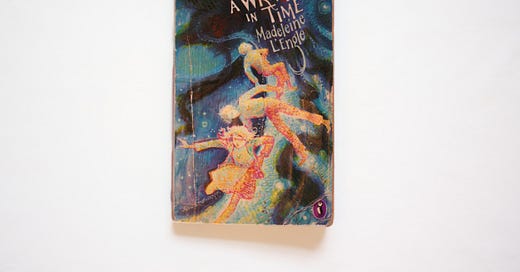Suddenly there was a great burst of light through the Darkness. The light spread out and where it touched the Darkness the Darkness disappeared. The light spread until the patch of Dark Thing had vanished, and there was only a gentle shining, and through the shining came the stars, clear and pure.
A Wrinkle in Time is a classic of 20th century children’s fiction. It is fantasy/science-fiction written for children from upper primary to early high school: a tale full of space and time travel, bizarre creatures, and strange and wonderful planets. It is also a tale about knowing whom to trust, about taking responsibility, about virtue and vice, and about love.
The plot, along with the setting, jumps around suddenly and somewhat erratically, and those who love fantasy and science fiction for intricate world-building may be disappointed by the paucity of clear explanations and the lack of consistency. There are certainly aspects that push one’s credulity—why do all the interplanetary beings speak the same language? why are some of them human, and some not?—but I found myself quite happy to go along with the necessary suspension of disbelief. Certain explanations are given, but they are not dwelt upon, and the reader is left to fill in many gaps as she pleases. The book is short and the pace intentionally fast, with the result that the imagination is fed but not overly coddled.
The fast pace and fantastical story will appeal to young readers, but L’Engle does not shy away from the serious. She clearly believes her readers capable of engaging with some important philosophical questions about the nature of freedom, about how the mundane vices we indulge set us in the way of evil, and about the one thing that evil cannot understand. (I’ll leave that to the reader to uncover.)
A curious feature of the blurb on our edition is that it centres the narrative on Charles Wallace, a four year old boy with strange gifts, rather than on his older sister, Meg. While Meg is far less ‘special’ than her younger brother, she is undoubtedly the chief protagonist. Charles learns one important lesson in the narrative, but Meg actually grows up. She begins the story a young girl pining for her lost father, believing that if he only came back everything in her life would be set right. The final stage of the narrative has her sent in place of her father to complete a mission which she reluctantly recognises as a calling she cannot pass on to another.
Readers of C.S. Lewis’ Cosmic Trilogy (a.k.a. the Ransom Trilogy) will likely wonder if L’Engle is intentionally drawing on aspects of his cosmology. (If you haven’t read Lewis’ lesser-known fantasy series, you can find two of the three books in our collection—but note that these are aimed at older readers than L’Engle’s books.)
L’Engle has drunk deeply from the well of life, and knows that all the world, whether familiar domestic scenes or strange and distant galaxies, is God’s world.




